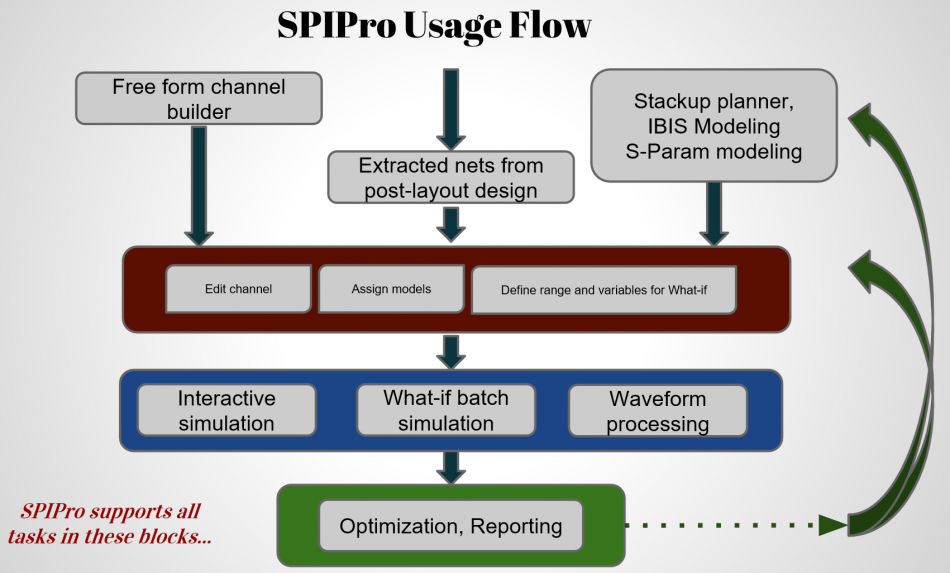Design Concepts of SPISimPro, SPISim’s flagship product:
Tasks for system electrical analysis:
There are many routine tasks involved in system’s electrical analysis. As a start, an engineer often needs to plan layer stackup, explore possible routing strategy and have a ball park estimate of trace impedance. This is especially true when the driver and receiver models (often comes in IBIS format) and connectors (often comes in sub-circuit or s-parameter format) are supplied by external vendors because the traces need to match their impedance in order to minimize the ISI (inter symbol interference). Thus even in planning stage, one often needs tools and flows to inspect, analyze these system level components. In addition, one may also need to generate spec. models according to data sheet when these external models are not yet available.
Once components are ready, one needs to assemble channel and explore the performance in pre-layout stage. This can be done either interactively or in a batch mode via a what-if simulation plan. The latter case is especially true when the variables involved in the channel are more than two or three, thus solution space can’t be explored linearly. A more sophisticated algorithm, such as design-of-experiment or space filling are often needed rather than full factorial simply due to the number of possible combinations of different variable values. Circuit simulator and field solver are then used to perform these analysis deterministically and a versatile waveform viewer or waveform data processor are often needed to extract these performance parameters. For DDR or serdes, industrial standards like JEDEC spec. and/or bit-error-rate like measurement are needed, both are beyond usual waveform measurement or simple visual inspection.
Once data points mapping from different channel variables’ values to its solution space are available, an optimization step is needed to construct a model not only to retro-fit the existing data points, but also to predict the optimized solution. Based on this predicted solution, different variables can be then set to obtain best channel performance.
When layout is done, one needs to extract associated nets from actual data and re-validate the performance against the designed channel. This is also true to a bottom up approach, where layout is done and one only wants to compare the performance against the spec. rather than looking for optimum solution. In either case, a design with geometrical (rather than just logical) information needs to be extracted to perform aforementioned interactive or what-if analysis in order to validate or fine-tune the generated layout.
SPISimPro’s offerings to help these SI/PI tasks:
SPISimPro is designed from ground up to address these routine SI/PI tasks’s needs. It’s integrated in a single GUI and can run cross platform. Different modules can be switched on the fly within the same window or launched as a separate standalone process. In brief, it offer the following modules to address the aforementioned process:
- CPro: A channel builder to allow creating schematic from scratch or from extracted post-layout nets. Models of different elements can be inspected and generated directly by B/S/TPro modules for an interactive or what-if sweep simulation.
- TPro: A layer stackup model generator and a transmission line performance inspector, estimator.
- BPro: An IBIS model generator or performance inspector. IBIS model can be generated scratch from transistor design, from existing simulation data or according to spec. from data sheet without any simulation needed.
- SPro: A S-parameter data inspector and analyzer. This module can also be used in lab or manufacturing environment to generate report for multiple s-parameters in various time domain/frequency domain/TDR figures and tables.
- VPro: A general purpose waveform viewer with spectrum, eye and other advanced data processing capabilities.
- NPro: A post-layout design browser and net extractors to construct physical (geometrical) based channel and exported as spice netlist or schematic in CPro for further analysis.
- MPro: A general purpose modeler or optimizer to create DOE, space filling or other simulation plan and map simulated/processed data points into prediction formula using linear, or non-linear (response surface modeling, neural network etc) models and predict the optimum solution.
- DPro: A DDR focused data processor to extract JEDEC parameters from simulation result for compliance testing.
Work flow:
The flow chart below summarizes SPISimPro’s usage flow:

Need more info?
Please visit individual modules’ page linked above for further details.

